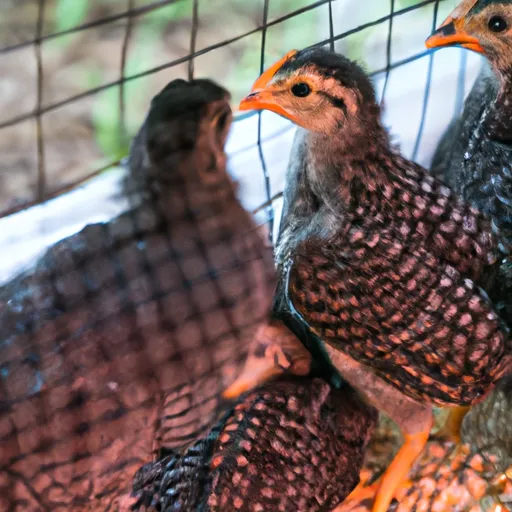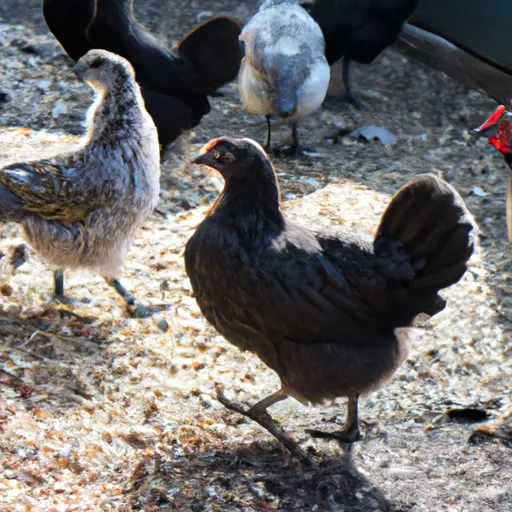Introducing New Chickens to the Flock
So, you've got a flock of chickens and you've decided to add some new members to the mix.
But wait, will your existing feathered friends accept these newcomers?

Introducing new chickens to an established flock can be a delicate process, as chickens are known for being territorial creatures.
In this article, we'll explore some tips and strategies on how to successfully introduce new chickens to your existing flock, ensuring a smooth transition and harmonious integration.
Plus, we'll address the age-old question of whether it's best to introduce new chickens during the day or at night. Get ready to learn the ins and outs of poultry diplomacy!
Types of Chickens
Choosing the Right Breed
When adding new chickens to your flock, it's important to consider the breed. Different breeds have different characteristics, personalities, and needs.
Some breeds are known for being more docile and friendly, while others can be more aggressive or independent.
Think about what you're looking for in a chicken and choose a breed that aligns with your preferences and the existing dynamics of your flock.
Considering the Age
The age of the new chickens is another crucial factor to consider. Introducing young chicks to the flock is generally easier than introducing adult or mature chickens.
Younger chickens are more adaptable and can integrate more easily into an existing flock.
However, if you're adding older chickens, it's essential to ensure they are healthy, vaccinated, and free from any diseases or parasites that could be transmitted to your existing flock.
Health and Temperament Assessment
Before adding new chickens to your flock, it's crucial to assess their health and temperament.

Look for signs of illness or injury, such as lethargy, ruffled feathers, or respiratory symptoms.
It's also important to observe their behavior and temperament to ensure they will be a good fit with the existing members of your flock.
Aggressive or overly dominant chickens may disrupt the pecking order and cause problems within the flock.
Quarantine Process
The Importance of Quarantine
Quarantining new chickens before introducing them to your existing flock is essential for maintaining the health and well-being of all your chickens.
Quarantine helps prevent the spread of diseases, parasites, or infections from new chickens to your existing flock.
Even if the new chickens appear healthy, they could still be carriers of diseases that can harm your entire flock.
Selecting an Isolation Area
When setting up a quarantine area, choose a separate space that is isolated from your existing flock.
This can be a separate coop, cage, or pen where the new chickens will be kept for a designated period. Ensure that the quarantine area is secure and provides adequate space for the new chickens to move around comfortably.
Duration of Quarantine
The duration of the quarantine period can vary depending on the health status and history of the new chickens. It is recommended to quarantine new chickens for at least 2-3 weeks to monitor them for any signs of illness or disease.
During this time, observe their behavior, monitor their eating and drinking habits, and check for any symptoms of illness.
If they remain healthy and show no signs of illness, they can be gradually introduced to the existing flock.
Preparing the Coop
Cleaning and Disinfecting
Before introducing the new chickens to the coop, it's important to thoroughly clean and disinfect the space.
Remove any accumulated waste or debris, clean the roosts and nesting boxes, and disinfect the area to eliminate any potential pathogens or parasites that may harm the new chickens or the existing flock.
Arranging Roosts and Nesting Boxes
Ensure that there are enough roosts and nesting boxes in the coop to accommodate the new chickens and the existing flock.
Chickens prefer to have their own space when roosting and laying eggs. Provide adequate roosting spots and nesting boxes to avoid any conflicts or competition between the chickens.
Providing Sufficient Space
Having sufficient space in the coop is crucial for maintaining a harmonious flock.
Make sure the coop is spacious enough to accommodate the number of chickens in your flock comfortably.
Overcrowding can lead to stress, aggression, and the spread of diseases. Provide enough space for the new chickens to move around and integrate with the existing flock.
Introducing New Chickens Gradually
Visual Introduction
Before physically introducing the new chickens to the existing flock, start with a visual introduction.
Place the new chickens in a secure crate or cage within the sight and hearing range of the existing flock.
This allows them to become familiar with each other's presence without direct physical contact.
Physical Separation with Fence
Once the chickens have become acquainted visually, introduce a physical separation using a fence or wire mesh. This allows the chickens to interact through the barrier, getting to know each other while still maintaining a certain level of separation and safety.
This gradual introduction helps reduce aggression and stress during the integration process.
Supervised Interaction
After the initial visual and physical introductions, supervise the chickens' interactions closely.
Gradually remove the separation barrier under close observation to ensure that no aggressive behavior occurs.
If any signs of aggression or fighting occur, separate the chickens immediately and try again after some time. Gradual and supervised interaction is key for a successful integration.
Observing the Behavior
Establishing Pecking Order
When introducing new chickens to an existing flock, it's common for a pecking order to be established.
Chickens have a natural hierarchy and will need to determine their ranks within the flock.
This can involve some pecking, chasing, and vocalization as they assert their dominance or establish their place in the social order.
It's essential to allow this process to occur as long as it doesn't escalate into aggressive behavior.
Indications of Aggression
While some level of pecking and chasing is normal during the integration process, it's important to monitor the behavior for signs of excessive aggression.
Aggressive behavior may include persistent chasing, excessive pecking, drawing blood, or relentless bullying.
If any of these aggressive behaviors are observed, separate the aggressive chicken and consider implementing strategies to address the problem.

Signs of Integration
Signs of integration between the new chickens and the existing flock can include peaceful coexistence, sharing of resources, and mutual grooming.
Watch for indications that the chickens are accepting each other, such as eating together, roosting together, or engaging in normal flock activities without aggressive behavior.
Gradual integration can take time, but positive signs of acceptance and integration indicate a successful introduction.
Feeding and Watering Tips
Maintaining Multiple Feeding Stations
When introducing new chickens to the flock, it's important to ensure that all chickens have access to food without competition or bullying.
Provide multiple feeding stations throughout the coop to prevent feed competition. This allows each chicken to access food easily and reduces the chances of aggressive behavior during feeding time.
Ensuring Adequate Water Supply
An ample supply of clean water is essential for the health and well-being of all chickens.
Make sure to provide sufficient water stations throughout the coop so that all chickens, both new and existing, have easy access to water at all times.
Monitor the water sources regularly to ensure cleanliness and refill as needed.
Avoiding Feed Competition
Adequate spacing between feeding stations can help minimize feed competition.
Chickens may become territorial or possessive over food, especially during the integration process.
Providing enough space for each chicken to eat separately can reduce stress and prevent aggressive behavior.
Consider providing separate feeding areas for the new chickens during the integration period until they are fully integrated into the flock.
Nighttime Introductions
Pros and Cons of Nighttime Introduction
Introducing new chickens to the flock at night has both advantages and disadvantages.
The darkness can help reduce aggression and territorial behavior among the chickens.
The existing flock will be less likely to notice the new chickens and may be more accepting of them in the darkness.
However, nighttime introductions can be challenging to monitor, and if any aggressive behavior occurs, it may go unnoticed until the morning.
Accommodating Darkness Adaptation
Chickens rely on their vision during the day, and introducing them to a new environment at night can disorient them.
To accommodate their darkness adaptation, provide ample sources of dim lighting near the coop entrance and roosts. This will make it easier for the new chickens to find their way around and locate the roosts during their first night with the flock.
Monitoring Nighttime Behavior
While nighttime introductions can be beneficial in reducing aggression, it's important to monitor the behavior of the chickens during this time.
If any aggressive behavior or excessive squabbling occurs, it may be necessary to intervene and separate the chickens.
Monitor their behavior closely throughout the night and address any issues promptly to ensure the safety and well-being of all chickens.
Dealing with Aggression and Bullying
Separation and Timeouts
If aggressive or bullying behavior occurs between chickens, it's essential to separate the aggressor from the rest of the flock.
This can be done by using temporary fencing or creating a separate area within the coop for the aggressive chicken. Giving them a timeout from the flock will help reduce stress and prevent further harm to other chickens.
Adding Hiding Spots or Distractions
Providing hiding spots or distractions within the coop can help alleviate aggression and bullying.
Adding extra roosts, perches, or even simple dividers can create additional spaces for chickens to escape aggression and establish their own safe zones.
Distractions like hanging treats, toys, or mirrors can also divert their attention and reduce aggressive behavior.
Supplementing with Poultry Supplements
To help reduce aggression and maintain overall flock health, consider supplementing the chickens' diet with poultry supplements.
Certain supplements, such as herbs or probiotics, can help promote a calm and balanced temperament among the chickens.
Consult with a veterinarian or poultry expert to determine the appropriate supplements for your flock.
Monitoring Health and Disease
Frequent Health Checks
Regular health checks for both new and existing chickens are crucial for identifying any signs of illness or disease. Monitor their general appearance, behavior, eating, and drinking habits, and check for any physical abnormalities.
Conduct regular health inspections, including checking for lice, mites, or other external parasites. Promptly address any health concerns to prevent the spread of diseases within the flock.
Common Diseases and Their Symptoms
Familiarize yourself with common chicken diseases and their symptoms to quickly identify any potential issues.
Common diseases include respiratory infections, coccidiosis, or diseases transmitted by external parasites. Look out for symptoms such as coughing, sneezing, diarrhea, abnormal droppings, weight loss, or lethargy.
Early detection and treatment can help prevent the spread of diseases and ensure the well-being of your flock.
Seeking Veterinary Assistance
If you notice any signs of illness or disease in your chickens, it's important to seek veterinary assistance promptly.
A veterinarian experienced in poultry health can provide a proper diagnosis, recommend treatment options, and offer guidance on how to prevent the spread of diseases. Regular veterinary visits can also help monitor the overall health of your flock and provide preventive care.
Introducing new chickens to your flock can be a rewarding experience, but it requires careful planning, consideration, and patience.

Choosing the right breed, assessing their health and temperament, and following a gradual introduction process are key to a successful integration.
Providing sufficient space, monitoring behavior, and ensuring a balanced diet contribute to a harmonious flock.
Regular health checks and seeking veterinary assistance, when needed, are essential for maintaining the health and well-being of all your chickens.
By following these steps and guidelines, you can successfully add new chickens to your flock and create a thriving community of happy and healthy chickens.
